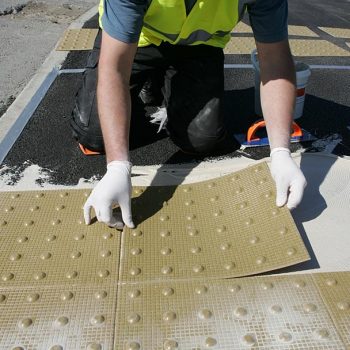
Lozenge Platform Edge On Street (LRT) Tactile Paving
The lozenge surface warns visually impaired people that they are approaching the edge of an on-street light rapid transit (LRT) platform.

Our surface mounted tactile paving tile systems provide a fast, easy and economical solution while complying with strict government guidance.
Tactile paving provides guidance and warning for visually impaired pedestrians. Our cost-effective GRP and resin/stone composite tactile paving has been designed to meet all relevant government guidance on the use of tactile paving contained in the document ‘Guidance on the Use of Tactile Paving Surfaces’. Not only are we trusted suppliers of cost-effective adhesive stick on tactiles, we also provide an installation service across the UK.
View all products


The Department of Transport places requirements on local authorities and duty holders to provide effective tactile paving. The guidance and warning that this provides for visually impaired pedestrians is vital for their safety.
Surface mounted tactile paving systems offer many advantages over traditionally used concrete materials. Not only do they provide greater longevity, the cost of installation is also lower.
With no excavation required, the installation of surface bonded tactile paving tiles takes a fraction of the time it would take to lay concrete pavers. Tests have also shown that composite tactile paving tiles are significantly harder wearing. They are, in fact, up to seven times more durable. Unlike concrete pavers, adhesive tactile paving tiles are not subject to freeze-thaw fracturing and spalling.
Our surface mounted tactile paving is constructed from the optimum materials for the job. The full range of self-adhesive tactile tiles we offer is manufactured from a polyurethane resin and stone composite (incorporating recycled material). Blister Platform Edge Off-Street and Corduroy tactiles are also available in corrosion resistant GRP, incorporating a coating of refined aluminium oxide granules.
Both types of tactile paving offer extreme durability and low potential for slips under both dry and wet conditions.

Tactile paving tiles must be installed in public areas where visually impaired persons could meet a hazard, such as:


We offer a full range of tactile paving tiles in the colours specified as appropriate by the Department for Transport document ‘Guidance on the Use of Tactile Paving Surfaces’. Some product types offer a choice of red, yellow, charcoal and grey. The only colour that should be selected is that which suits the installation application.
Learn more with our complete guide.
Our tactile paving installation can cater to all hazard warning requirements including:
View and download all product specification sheets.
They are also compliant with the Equality Act 2010.

Site surveys: We can offer advice, insight and free quotations through in-person site surveys or via supplied drawings/media.
Design drawing and 3D rendering: We can help you visualise your concepts through 3D rendered CAD models.
Engineering and standards verification: Amongst others, we have worked with Sheffield Hallam University Centre for Infrastructure Management and Exova (Element Group) to provide independently verified conformance to BS and EN tests.
Installations team: Our fully trained team can install our products throughout the UK.


The lozenge surface warns visually impaired people that they are approaching the edge of an on-street light rapid transit (LRT) platform.

A solvent-free, epoxy adhesive provides the moisture tolerant bonding of tactile tiles to concrete, asphalt, timber, metals & ceramics.

Used in conjunction with a segregated shared cycle track/footway to advise visually impaired people of the correct side to enter.

Guidance path surface guides visually impaired people along a route when the traditional cues, such as a property line or kerb edge, are not available.

The corduroy hazard warning tactile paving surface is used to warn visually impaired people of the presence of specific hazards.

The offset blister pattern tactile paving is used to advise visually impaired people of the edge of all off-street railway platforms.

The blister surface of this tactile paving warns visually impaired people where the footway ends and the carriageway begins.
27th March 2020
We would like to reassure all customers and enquirers that we remain open for business, while carefully following Government guidelines issued here:
https://www.gov.uk/coronavirus
The majority of our administration staff are working remotely and we have rostered production staff to make numbers available to meet demand.
We are able to provide the full range of our standard products from stock to serve any ongoing requirements you may have and will be pleased to receive any invitations to quote for future projects.
At the present time, in accordance with social distancing regulations we will not be conducting face to face meetings with business partners until further notice. However it may be possible to arrange video link meetings if required, please contact us for further information.
Collections of orders from our workshops are possible, by prior arrangement only please and visitors are reminded to observe the standard 2m distancing rules, for the safety of all.
Our transport partners are all providing us with a normal service.
We will update this statement if required and following any further guidance issued by the UK Government.
We wish you well.